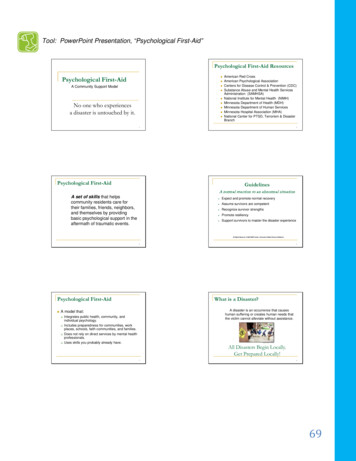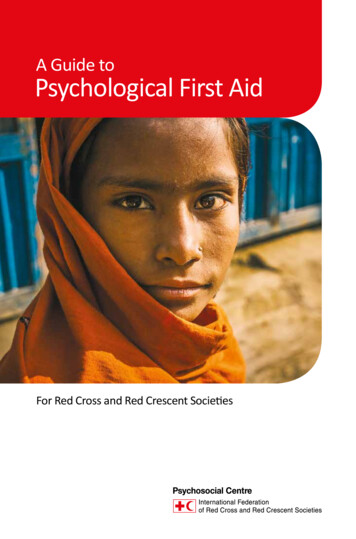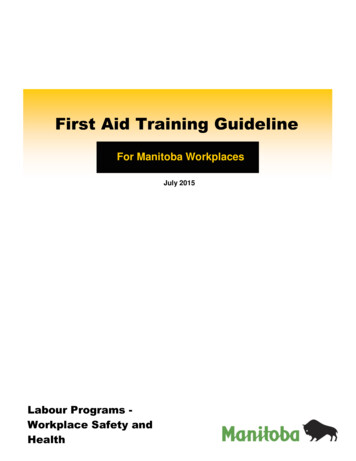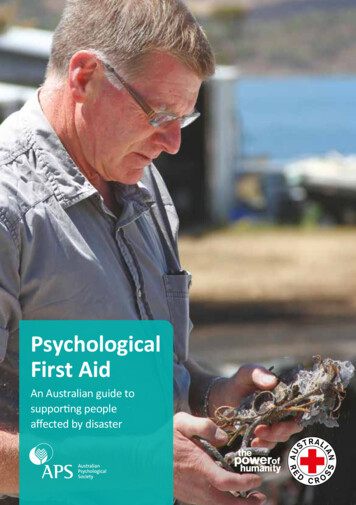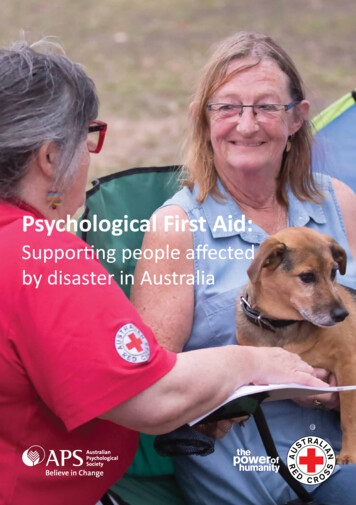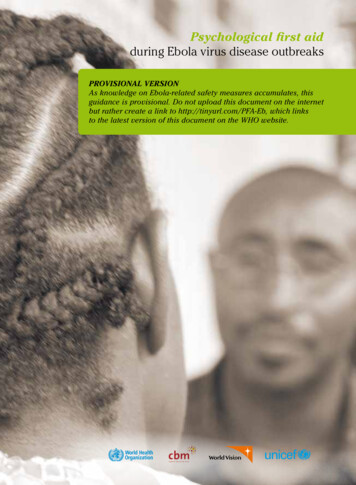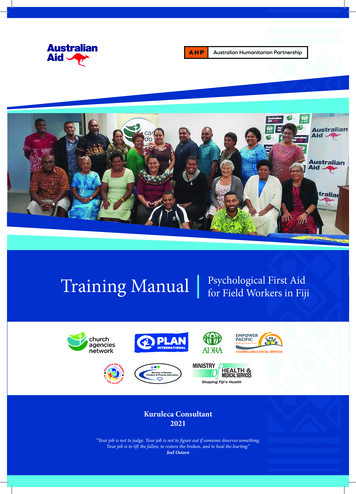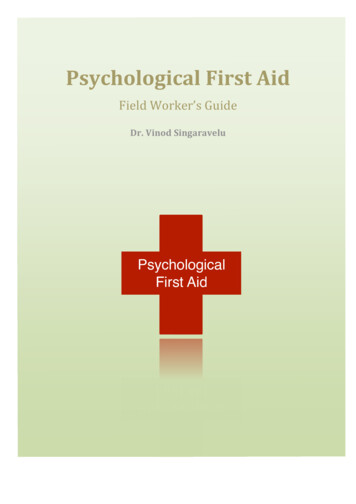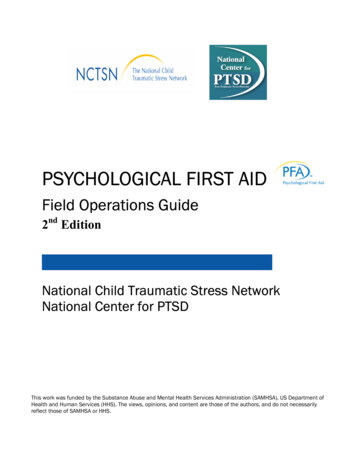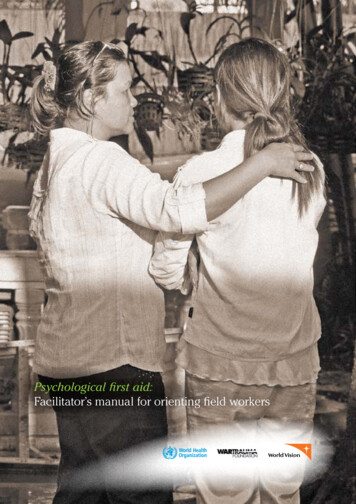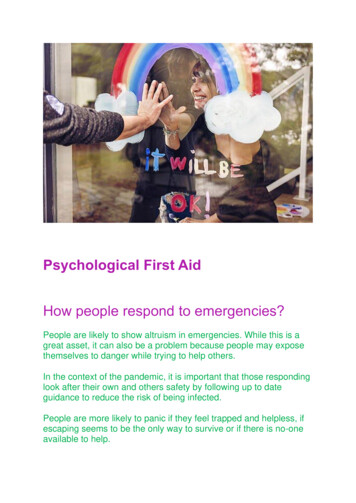
Transcription
Psychological First AidHow people respond to emergencies?People are likely to show altruism in emergencies. While this is agreat asset, it can also be a problem because people may exposethemselves to danger while trying to help others.In the context of the pandemic, it is important that those respondinglook after their own and others safety by following up to dateguidance to reduce the risk of being infected.People are more likely to panic if they feel trapped and helpless, ifescaping seems to be the only way to survive or if there is no-oneavailable to help.
The majority of people who have been restricted in movement dueto lockdown measures have cooperated in the knowledge that thisis protecting themselves and others around them.How do emergencies impact mentalhealth?Traumatic events are events that are stressful, frightening ordistressing.During the COVID-19 pandemic, the whole of the society is likely tobe affected to some degree, including children, young people, andadults. Some people may have specific traumatic experiences suchas getting the illness, bereavement, or being in isolation; or may bemore susceptible to psychosocial impacts.Some people may have no obvious signs of distress. Many peopleexperience immediate distress, but they recover quickly. Othersthough may display considerable distress shortly after an event.Most people will recover, given sufficient time and support. While asignificant minority may not fully recover without interventionsoffered by health professionals.People’s abilities to cope, and speeds of recovery are increased, ifthey are offered social support in the aftermath of a traumatic event.Post-traumatic stress disorderMany people have heard of post-traumatic stress disorder (PTSD).PTSD is relatively unusual after emergencies. People are as likelyto develop anxiety disorders and depression, and more likely todevelop problems with misuse of alcohol than they are to developPTSD.
It is difficult to know who might suffer from it immediately aftertraumatic events as diagnoses are not made until symptoms havepersisted for at least a month. Providing PFA can reduce the risk ofpeople developing PTSD.Signs of distressThere are some signs of distress people may exhibit that you canlook out for in the hours and days following an emergency ortraumatic event.Uncertainty, loss of control and disruption to normal supports arekey features of the pandemic that may lead to signs of distress inanyone, not just those exposed to specific traumas. These signsmay be less easy to spot in people with cognitive difference.Below are some common reactions to stress, that maybe useful tohelp establish if someone is showing signs of distress:Emotional reactionsAre reactions connected to how a person is feeling, and how theyperceive they are coping with a situation. A person may sharefeelings of: Fear and anxiety Helplessness Hopelessness/demotivation Fear of the infection Guilt Anger or frustration Sadness Loneliness
Cognitive reactionsThese are reactions that connected to persons thoughts, ability tomanage those. Reactions may include: Impaired concentration Confusion or disorientation Intrusive thoughts Dissociation (feeling disconnected from yourself or the worldaround you) or denial. Hypervigilance (being always on alert) Impaired memorySocial reactionsAre reactions connected to how a person interacts on a social leveland looks after their basic personal needs. You may see signs suchas: Reduced confidence or self-esteem Withdrawal Irritability Interpersonal conflict Avoidance Lack of self-care Obsessive/compulsive behaviours, particularly around hygienein the context of the pandemic
Physical reactionsSome people will have actual physical reactions, common reactionsare: Somatic complaints, any bodily system can be affected: typicalsymptoms include (list):obreathing difficultiesoincreased heart rate and blood pressureosweatingopalpitationsomuscle tensionogastrointestinal symptomsosomatic symptoms Hyper-arousal Headaches Change in eating habits. Reduced energy InsomniaAdvice for supporting those with cognitive difference.Like everybody, people with a learning disability, autistic people andpeople affected by dementia and other cognitive difference, willrespond to and show distress differently from person to person. Donot assume that behaviour that is different to ‘normal’ is actuallydifferent for that individual – but also do not assume that this is justbecause of their cognitive difference.Many people will be able to discuss how they are being affectedand whether there has been any change to their thoughts, feelingsor actions. Those close to the person may be able to help and
people may be able to share information such as learning disabilityor autism passports or other records that set out how the personusually reacts and how to spot signs of distress or anxiety.Secondary stressorsThe risk of wider social problems such as difficulties with housingand employment, relational problems, and mental health problemsincreases if emergencies or the effects of disasters are prolonged.Some disasters begin a chain of events that may continue to causestress. In the case of the pandemic many people may beexperiencing problems with employment or education disruption,financial pressures or caring responsibilities for children, the elderly,or people with disability.These problems cause people more stress on top of the strain thatcomes from experiencing the event that provoked these continuingproblems. These types of stress are called ‘secondary stressors’.It is important that interventions and social support are in place tohelp people deal with these sources of stress, adapt, and recover.Longer-term effects.Those who continue to experience secondary stressors are morelikely to experience persistent distress. Persistent distress may leadto: Anxiety
Depression Substance use disorders Adjustment disorders Post-traumatic stress disorder Worsening of existing mental disordersDistress or mental health problems?Around 80% of people experience some form of distress in the firsttwo weeks after experiencing a disaster or emergency. Usually,they will be supported effectively by their families and communitiesand prefer to be supported in this way.A minority of these, up to 20% of people affected, may develop amental health problem, and will require professional assessmentand, possibly, intervention.You should help people understand that their distress is anticipatedand is likely part of a normal adjustment process. However, theyshould seek professional advice if their distress lasts for more thantwo weeks without diminishing.DistressResponding to disasters with strong emotions such as anger, guilt,anxiety, and sadness is a normal way of adapting to circumstancesand will usually be temporary. Some may experience changes inbehaviours or question their beliefs; or find it difficult to function theway they normally do. These are also likely to be temporary butmay benefit from support.Mental health problemsPeople who are developing disorders may have symptoms similarto people who are distressed. The difference between distress and
disorder is in the persistence, severity, and effects of thesesymptoms on people’s lives.In these circumstances, the effects could be said to bedisproportionate to the severity of the stress.People who continue to suffer event-related symptoms or developnew symptoms two weeks after an event should seek professionaladvice.Be alert for signs of physical illness.It is important to remember that symptoms such as feeling sweaty,heart palpitations and shortness of breath can be signs of anunderlying physical illness. In the case of the pandemic, symptomssuch as shortness of breath might be due to anxiety, infection, orboth.A high temperature, new continuous cough or loss of taste or smellmay indicate COVID-19 infection. It is important to note that stressdoes not cause high temperature.You should be careful not to assume that all symptoms are due tostress and ensure as part of your PFA response that you signpostpeople to appropriate and timely medical support.People may be frightened of catching COVID-19 at medical facilitiesand so you may need to support them to take the next step, such asassisting them in calling 111, their GP or an ambulance.It is also important to remember that some people may turn tosubstances that may harm their health as a way of coping, such asincreased alcohol, tobacco, or drug use. These may adverselyimpact their physical or mental health and may cause physicalsymptoms. It is important to consider these and ask about theircoping mechanisms in a sensitive way.
Resilience and copingResilience is the ability to cope with, adapt to, or bounce back afterexperiencing adverse events. Some definitions take this further andspeak of ‘bouncing forward’: where experiencing disruptive,stressful, or challenging life events provides individuals orcommunities with additional protective and coping skills, thusproviding a route to growth and development.Such a positive outcome is likely to depend on: How much support we receive at the time. Our previous experience of distressing events Our perceived capacity to cope with the situation. The nature and severity of the situation itselfA person’s psychosocial resilience and willingness to accept socialsupport, may assist in how they cope.Psychosocial resilience:The following provides a key to good psychosocial resilience: Being able to accept and use psychosocial support. Being able to deal with circumstances realistically. Having strong self-belief and valuePsychosocial resilience is NOT the same as: Absence of mental disorders Absence of distress Absence of risk
Social support:Social support is not only about providing an individual withpractical assistance, but also consists of interactions andrelationships that are felt to be caring, comforting and readilyavailable in times of need.Social support might be provided by anyone within a person’s socialnetwork: friends, relatives, individuals in the community as well asstaff or volunteers working in the public sector.Coping wellThere are positive things people can do to help themselves torecover. They may try to reduce stress by problem solving, or theycan adapt to the stress by accepting it. This type of positive copingshould be encouraged.People sometimes behave in ways that are less helpful such asavoiding or denying their problems. Denial may help people to copein the short-term, but it is not a helpful long-term way of coping.Worrying excessively about events can increase suffering in thelonger-term. People who show persistent denial or worrying shouldbe signposted to assessment by healthcare agencies. However, noone should be forced to talk or access help if they are not ready to.
Who can benefit from PFA?Anyone can benefit from a PFA approach.However, it is important to bear in mind that PFA is not specialistcare. People should be referred to further support as needed, forinstance: People in need of immediate medical care or other specialistsupport such as safeguarding services should be linked to theappropriate professional practitioners. People who are so distressed that they are incapable of takingcare of themselves or their children, or people who may be indanger of hurting themselves or others, should be referred forappropriate assessment by professional practitioners.Some people may not want help and their wishes should berespected. However, if someone is behaving in a way that putsvulnerable people in their care at risk then please considersafeguarding or talk to your supervisor.Those with cognitive differenceThe mental health of people with cognitive difference can also beaffected by the Covid-19 pandemic, and this is made more likely ifinformation is hard to understand.For many people with a learning disability, autistic people andpeople affected by dementia, the PFA approach of listening andtreating them with compassion is just as applicable, though youmay need to alter your communication slightly. If the impact ofsomeone’s cognitive difference is very great, it may be moreappropriate to involve someone with specialist expertise.
If someone is behaving in a way that puts vulnerable people in theircare at risk then please consider safeguarding or talk to yoursupervisor.In the next step we look at who can deliver PFA and the skills yourequire to be a good PFA practitioner.Who can deliver PFA? And the skills you require.You do not have to be a specialist to deliver PFA. Many people inhelping roles will already be delivering PFA without realising it.Those who may benefit from this training include: Health and social care staff First responders e.g., police, ambulance, firefighters Frontline public sector staff e.g., those working in housing oremployment services. Essential Workers e.g., those working in food delivery, funeralcare, sanitation. Community leaders and groups Volunteers Supervisors and managers supporting staff or volunteers.Those working with children and young people may benefit frommore specific training, such as that provided by Minded.The skills of a good PFA practitionerA good PFA practitioner will include:
Being a good listener is an important part of PFA is identifyingwhat help and support each person requires. Be well informed about the COVID-19 pandemic, so you cangive people accurate information. It is important that peoplecan trust you. Have the ability to encourage active coping by for instance,helping people make decisions about the next steps they willtake. Encourage and help people to connect with their loved ones,or community and spiritual supports. Be aware of people’s cultural preferences and needs andadopt a non-judgemental approach. Know how to look after their own wellbeing and access socialsupport through friends, family, supervision, or managers.Social supportSocial support is important not only for those you are supporting,but also for yourself.Social support consists of both practical assistance andrelationships/interactions that are perceived to be caring, comfortingand readily available in times of need. It can come from a widerange of individuals including friends, family, and colleagues.PreparationYou should prepare before delivering Psychological First Aid. Thefollowing areas will be covered: Understanding your role Learning about COVID-19
Learning about available services and supports Learning about safety protocols Respecting safety, dignity and rightsYou need to be aware of your role and the limitations of your role.Your purpose, for example, is not to provide medical assistance(unless you are appropriately trained to do so).If someone requires urgent medical assistance, you should ensurethey are seen by someone who is trained to deal with this need.This may require you to call an ambulance or instruct someone elseto call an ambulance.It is also important that you do not interfere with emergency,healthcare, or other specialised response services such as those ofyour local Health Protection Team.Follow instructions from these services and if they are involvedconsider whether it is appropriate for you to deliver PFA at thispoint, or to wait until after they have completed their tasks.Learn about COVID-19Before delivering PFA you should be familiar with basic facts aboutCOVID-19. Information about COVID-19 is changing on a daily
basis as we learn more about it, so it is important to stay up to date.You should consider: Learning how COVID-19 is transmitted, and how to stayhealthy and avoid spreading the disease. Learning the risks, signs, and symptoms of infection, as wellas how to proceed in case you have been exposed tosomeone with symptoms or who tests positive for COVID-19,or you become ill. You should use reliable and up to date sources of informationsuch as the Government or NHS web pages. You may work for an organisation they may also provide youwith relevant guidance and information specific to your role orarea.Services and supportLearn about available services and supports that are available.
You may want to signpost people to further practical, emotional, orsocial support. It would be useful to learn the contact information forrelevant resources in your area: Local authority support for social care, education, housing,finance, and related public services Psychological support by accessing Psychological Therapy(IAPT) services. Voluntary support such as Mutual Aid and Food Banks Local community initiatives Communication tools to support people remotely wherenecessary. Wellbeing support resources, many of which might beaccessed online, such as Every Mind Matters and Rise Above.Delivering support safelyYour safety is important and understanding how to deliver supportsafely is essential.It is important that while you deliver PFA you follow the currentrecommendations to prevent the spread of infection.You should clarify whether you should be wearing personalprotective equipment (PPE) and when and how to use it.If you are delivering support remotely (via phone or video), thefollowing considerations should be taken into account:You should make sure the mode of communication you are using issafe, secure, and easy to use. Check there is sufficient time for technical troubleshooting. Make sure you are clear how long the call is going to be.
You should speak slowly, clearly, and calmly, communicatingempathy and warmth. You, and where possible the caller, should have your ownprivate space to complete the call, ensuring that you will notbe overheard or interrupted. You should be aware of your own limits.Respecting safety, dignity, and rightsThe basic principles of any type of essential psychosocial care,including PFA, are to respect the safety, dignity, and rights ofanyone you are helping.The specific nature of COVID-19 is that many people can becarriers without having symptoms, and the virus has rapidly spreadamong communities and globally. People suspected to be carryingthe virus, or who are ill with COVID-19 may suffer distrust, stigma,and discrimination. Consider how you would like to be treated in that situation andtreat people in the same way. Do not expose anyone to further stigma or discrimination. Treat all people with respect and ensure people can accesshelp fairly and without discrimination, regardless of age,gender, or ethnic background, and regardless of infectionstatus, illness, or work in the COVID-19 response.
Respecting culture, religion, and languageThe cultural norms and practices of the people you are helpingmust be respected: this includes adapting your behaviour toaccommodate people’s gender, sex, preferences, and authority.An example of that is considering what physical interaction isacceptable. If touching is allowed under guidelines to prevent thespread of infection; would it be acceptable to the person you arehelping to touch their shoulder?In some areas of the UK there may be many people who do notspeak English. It is important to try to find helpers who can speak topeople in their own language so that they can communicateeffectively.Speaking to religious leaders or being given opportunities to praycan be very helpful to some people and this should be respectedand facilitated where possible.Performing a 'Look' assessmentLook and consider the approach to assessment when performingPFA.
In this activity we will go into detail about the steps you need to taketo: Step 1: Identify people who need help. Step 2: Assessing support needs. Step 3: Approach safely Step 4: Identify further support needs.Identifying those in need of PFAThe first step you need to take is to identify people who need help.This could be: people who appear to be distressed. people who are actively seeking support for psychosocialneeds. people seeking support for other needs but who areexperiencing psychosocial distress. people your organisation are in touch with who have beenidentified as vulnerable to COVID-19 or to mental health andpsychosocial impacts of the pandemic.While some may actively seek support for their psychosocial needs,others may present in different ways.People in distress may be upset, crying, irritable, anxious, oragitated; or you may notice that they go silent: this is especiallytypical of those experiencing domestic violence. Remember thatthose with cognitive differences may not show typical signs ofdistress.Some may be looking for other support but be in distress – forexample presenting with somatic symptoms to health services; or
asking for housing support but also feeling very anxious about theirresponsibilities and keeping going.Assessing support needsAssessing the needs of those you are supporting, is an essentialstep in the ‘Look’ assessment, to ensure that you understand theirsituation and can provide the most appropriate support for theirneeds.Get Background InformationFind out as much about the situation as you can before youapproach. For example; has the person been infected or in contactwith someone with COVID-19. What measures you need to take toprevent the spread of infection.Find out if the person has any particular communication needs.Identify immediate needs.Address the person’s immediate needs - are they cold, thirsty,hungry?You may be able to directly help them with food, shelter, or otheressential needs; or direct them to support services that might helpthem.Assessing support needsPeople’s needs for support depend on the nature of the situationand their own circumstances. You should ask people and theirfamilies about their support needs and how they are being met. Thiscan include practical measures: Basic needs such as food, water, or shelter Adhering to infection control measures – for exampleaccessing personal protective equipment
Daily care such as washing and dressing or households taskssuch as shopping, cooking, cleaning. Medical history and medications (while emphasising that youare not a medical professional, if you are not) Support with caring responsibilities for children, elderly orthose with learning or other disabilities Advice or assistance with finances, housing, employment,educationSome people will have less practical support needs, and maybenefit from: Someone to speak to who feels trusted and can providecomfort. Finding meaningful or purposeful activityYou can provide immediate support by being there to talk.Helping someone to work through their concerns and problem solvein order to access the social support available to them, can helpthem restore confidence in their ability to cope and sense of controlover their lives which can be disrupted when experiencing a crisis.Ensure the safety of yourself and others.Follow appropriate guidelines to reduce the risk of infection. Thismay mean delivering your support remotely. Do not put yourself atrisk.People in isolation may be exposed to violence or other risks. Youshould explore with people whether they feel safe and if there areother places they can go to for refuge or respite. Also look into thesafety of vulnerable dependents such as children, elderly or thosewith dementia or learning disabilities.
Familiarise yourself with local safeguarding policy and whether youneed to involve police or social services.Identifying high risk groupsThose at high risk include those exposed to trauma during thepandemic may include: People who have been infected and their relatives, especiallyif there has been a bereavement. Those looking after people who are infected, for examplehealth and care staff, professional first responders. They willbe exposed to stressful and emotional situations; may suffer‘moral injury’ if forced to make decisions that don’t align withtheir values; and may have increased anxiety about gettingthe infection and/or passing on to family. People at increased risk of severe illness with COVID-19. Thisincludes those classed as ‘clinically vulnerable’. People in crowded homes, institutions such as prisons orresidential homes or those looking after people with impairedcapacity to understand and adhere to measures to prevent thespread of infection.For these groups, there is also a risk of stigmatization, as peoplemay fear infection from them, which will also impact on their mentalhealth.Others may be particularly vulnerable to secondary stressors and/orsocial distancing measures: Those with pre-existing mental health problems, whosecondition may be exacerbated by the pandemic. Those already suffering from financial, employment or housinginsecurity.
Those suffering from domestic or other forms of abuse(physical, emotional, sexual, financial, neglect) which may beexacerbated due to social distancing measures. Increasedstress related to the pandemic may also impact on conflict orsubstance use and increase risk of domestic abuse. Groups who may be marginalized or excluded and lackaccess to supports such as young carers, homeless persons,refugees and migrants, offenders, trafficked persons. Groups who are disproportionately impacted by controlmeasures e.g.oSingle parentsoThose on freelancing or zero hours contractsoYoung people who have had their education andprogression disrupted.Identifying those with extra needsSome groups may need particular considerations as they may havelimited ability to look after their own health and wellbeing and bedependent on support from others. It is worth noting that thesegroups may be more vulnerable to neglect or other types of abuse.Cognitive difference:People with a learning disability, autistic people and people affectedby dementia or other cognitive differences may understand andrespond to information differently.This may be due to difficulty understanding the situation andguidance that is issued. It may be due to difficulty understanding or
expressing emotional responses. And it may be due to difficultycoping with changes to routine, including no longer being able tosee family and friends.While there is no one right way to adapt your communication, if youknow in advance that someone has a cognitive difference you canprepare by being ready to change how you communicate - you mayneed to use different words, or to allow people more time to thinkand talk through information. Use clear, direct language.Remember that everyone is different. In particular, autistic peoplevary widely in how they understand and respond to information.Many will not need any changes in how you communicate. NHSEngland and the Royal Voluntary Service provide factsheets forNHS Volunteer Responders about supporting autistic people andpeople with dementia that include tips on good communication.ChildrenChildren may be directly affected by an event or may be indirectlyaffected if, for example, someone on whom they are dependent isaffected. In case of the pandemic, they are likely to experiencedisruption to normal routines and potentially loss of loved ones.Children are resilient in the face of emergencies. However, theirreactions depend on: Their age and developmental level Their proximity to the events Their exposure to events that impact on family members,whether family members have been directly affected or not. Personal, family and material losses Family’s and community’s responses
Young PeopleSome preteens and teenagers respond to worrying situations byacting out. This could include reckless driving, and alcohol or druguse.Others may become afraid to leave the home. They may cut backon how much time they connect with their friends. They may haveconcerns about how the school closures and exam cancellationswill affect them.They can feel overwhelmed by their intense emotions and feelunable to talk about them. Their emotions may lead to increasedarguing and even fighting with siblings, parents, carers, or otheradults.Clinically vulnerable groupsOlder people and those in clinically vulnerable groupsThis includes those with older adults, those with underlying medicalproblems and pregnant women.They all may have particular anxieties about getting the infection,but also may have complex needs which make them dependent onaccessing support and care both informally and from services.Older people may also have problems with mobility, eyesight orhearing that increase their support needs.People at risk of discrimination or violence.Some people are at risk of discrimination due to race, class,disability, gender, or sexuality. In the context of pandemics,discrimination may occur towards those infected or at high risk ofinfection, which will increase psychosocial stress they are
experiencing. There are disparities in those who are impacted byCOVID-19, for example higher rates in BAME communities andthose in more deprived areas, which may make discrimination morelikely. Some may find it difficult to distance from abusiverelationships or situations when in isolation or confined to an area.Heightened stress related to the pandemic may increase risk ofabuse occurring.You should be sensitive to the possibility of discriminationoccurring; avoid encouraging negative view of those at high risk andencourage people to seek support where appropriate.Listen. ‘Listen’ to understand the specific needs of those you support. ‘Link’ to other support resources and services Supporting yourself and colleagues: how to look after yourown and colleagues’ wellbeing while working during COVID19.We have considered how to ‘prepare’ and ‘look’ before deliveringPsychological First Aid. You should prepare by thinking about yourrole, what information you need to know about COVID-19, theavailable services and support, and that you understand the safetyprotocols. while respecting safety, dignity, and rights. By preparing,for doing your ‘Look’ assessment following the four steps. Step 1: Identify people who need help. Step 2: Assessing support needs. Step 3: Approach safely Step 4: Identify further support needs.It will help you to gain more valuable and relevant information, inorder to make an
Psychological First Aid How people respond to emergencies? People are likely to show altruism in emergencies. While this is a great asset, it can also be a problem because people may expose themselves to danger while trying to help others. In the context of the pandemi


